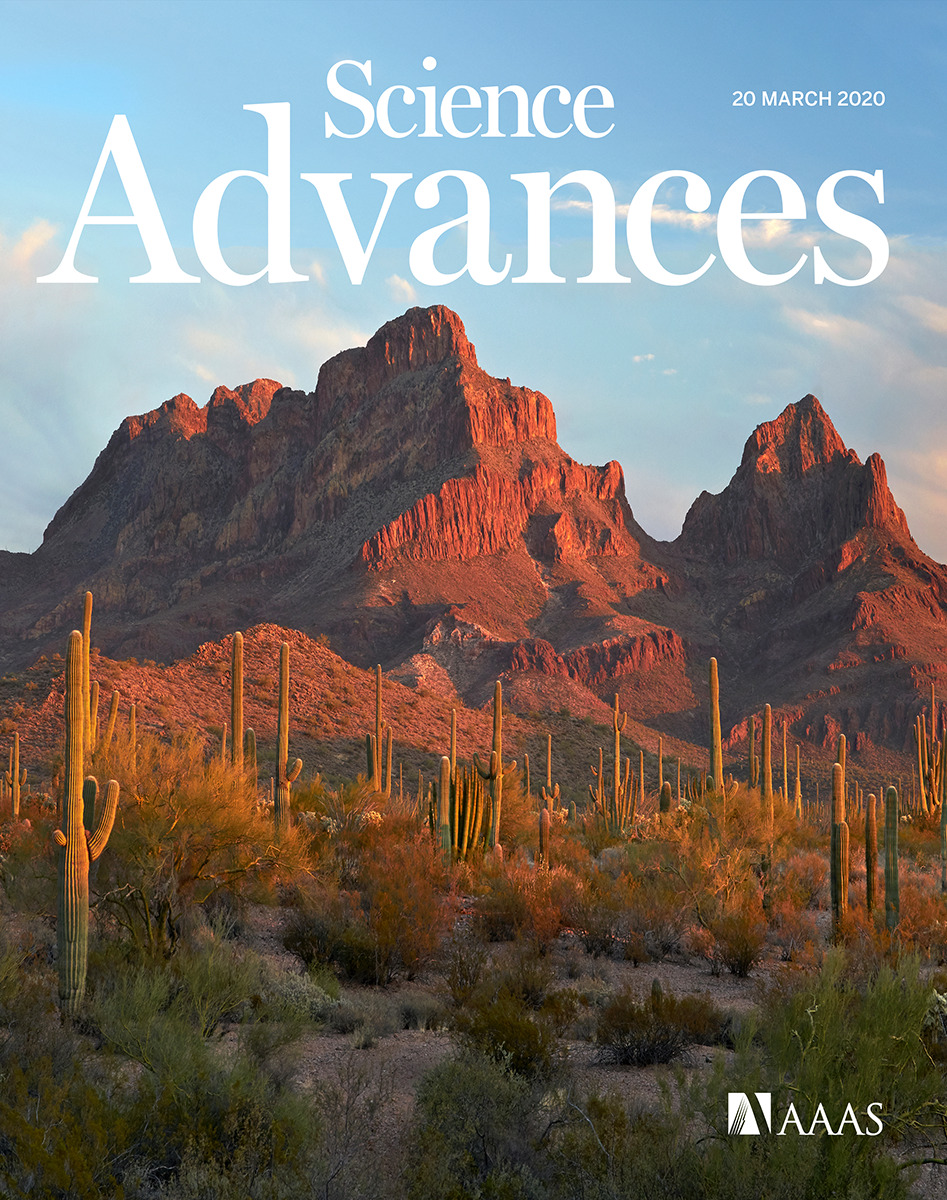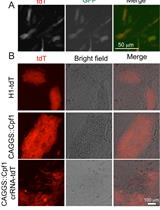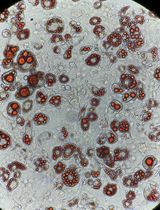- EN - English
- CN - 中文
Conditional Gene Editing in Presynaptic Extinction-ensemble Cells via the CRISPR-SaCas9 System
通过 CRISPR-SaCas9 系统在突触前灭绝集合细胞中进行条件基因编辑
发布: 2021年12月05日第11卷第23期 DOI: 10.21769/BioProtoc.4246 浏览次数: 2881
评审: Olga SinHélène LégerAbraam Yakoub

相关实验方案
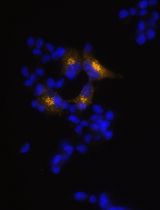
利用EpiCRISPR系统通过靶向DNA甲基化诱导Alpha TC1-6细胞产生胰岛素
Marija B. Đorđević [...] Melita S. Vidaković
2025年10月20日 835 阅读
Abstract
The CRISPR-Cas9 enables efficient gene editing in various cell types, including post-mitotic neurons. However, neuronal ensembles in the same brain region can still be functionally or anatomically different, and such heterogeneity requires gene editing in specific neuronal populations. We recently developed a CRISPR-SaCas9 system-based technique. Combined with activity-dependent cell-labeling methods and anterograde/retrograde adeno-associated virus (AAV) vectors, this technique achieves function- and projection-specific gene editing in the mammalian brain. We showed that perturbing cbp (CREB-binding protein) in extinction-ensemble neurons among amygdala-projecting infralimbic cortex (IL) cells impaired fear extinction learning, demonstrating the high efficiency in regulation of extinction learning with CRISPR-Cas9. Here, we describe a detailed protocol of gene perturbation in presynaptic extinction-ensemble neurons in adult rats, including gRNA design, gRNA evaluation in vitro, stereotaxic AAV injection, and contextual fear conditioning. The high specificity and efficiency of projection- and function-specific CRISPR-SaCas9 system can be widely applied in neural circuitry studies.
Background
In a brain region, neuronal ensembles can divide into distinct subpopulations, either functionally, by their recruitment in various tasks, or anatomically, by their efferent/afferent connections. It is still challenging to decipher the logic of complex neuronal networks and molecular underpinnings of memory, which highlights the requirement for conditional gene perturbation in the heterogeneous brain with precise spatial and temporal resolution. A conditional recombination system has been broadly applied to investigate brain function with spatiotemporal accuracy, but the construction of germline-modified mutant strains can be time-consuming and labor-intensive, especially for transgenic rats.
Emerged in 2013, the CRISPR-Cas9 system induces frameshifting insertion/deletion (indel) mutations, thus allowing efficient perturbation of endogenous genes in different cell types (Cong et al., 2013) and functional analysis of specific genes in the mammalian brain (Swiech et al., 2015). Cre-loxP tools that allow conditional control of spatiotemporal expression of Cas9 have been established in rodents (Platt et al., 2014; Bäck et al., 2019), enabling precise gene manipulation in defined neuronal types, including engram cells, the putative substrate for memory storage (Liu et al., 2012). Nevertheless, the restrictive cargo size (usually less than 4.5 kb) of the highly versatile AAV vehicle presents an obstacle for efficient packaging of the commonly used SpCas9 (Streptococcus pyogenes, 4.2 kb). By contrast, the Cas9 ortholog from Staphylococcus aureus (SaCas9, 3.2 kb) is 1 kb shorter but edits the genome with an efficiency similar to SpCas9 (Ran et al., 2015). Combining SaCas9, AAV vector, and activity-dependent cell-labeling techniques, we recently developed a conditional genome perturbation in engram cells bearing memory storage or extinction, thereby impairing the remote memory or extinction learning in rats (Sun et al., 2020).
As a proof-of-principle protocol, we describe here how to knockdown cbp in presynaptic IL extinction-ensemble neurons (Figure 1), which can be used to investigate the circuit and molecular basis of memory.
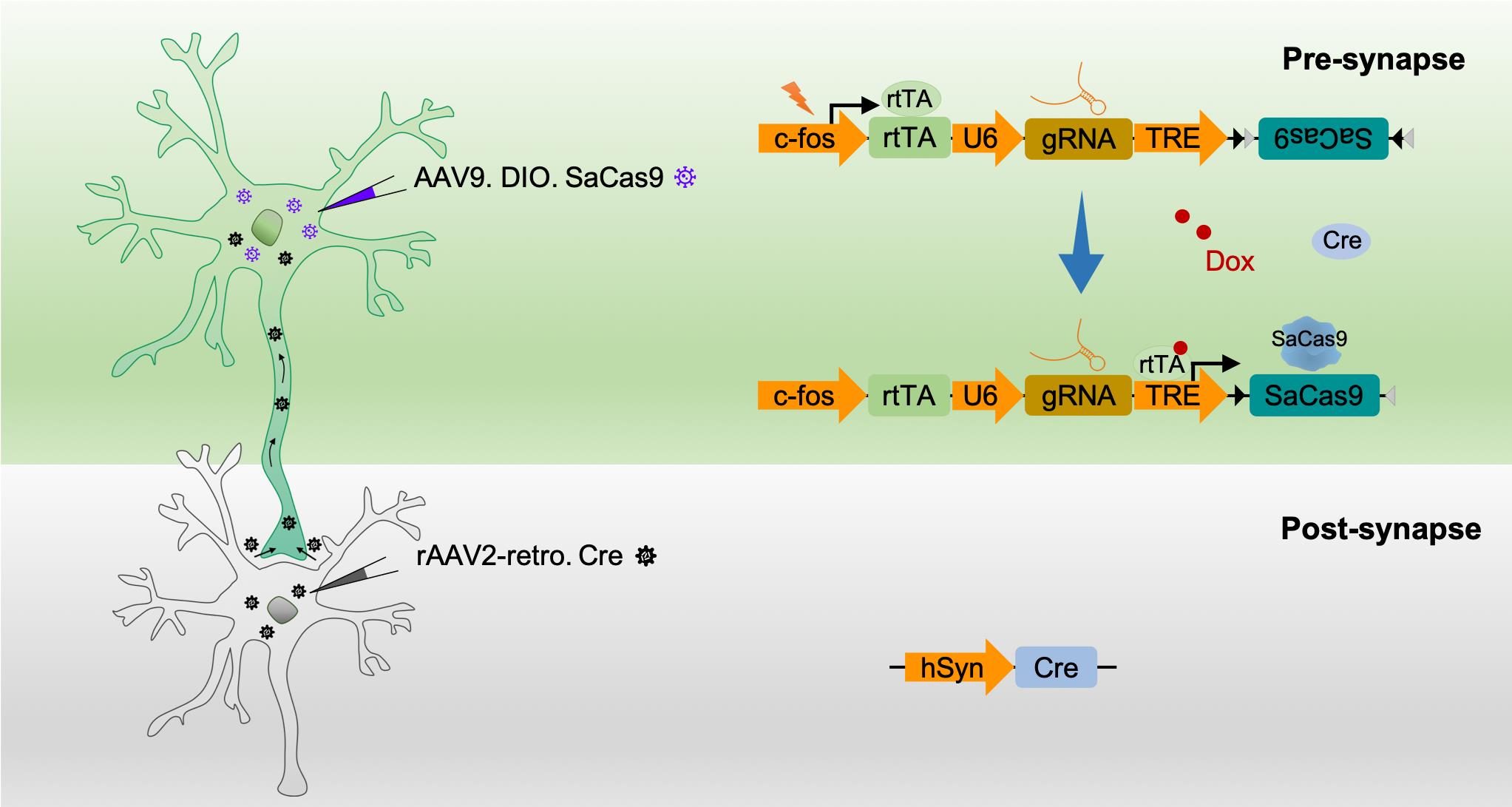
Figure 1. Schematic of conditional gene editing in the brain. With doxycycline (Dox), training induces the expression of reverse tetracycline transactivator (rtTA), which binds to tetracycline responsive element (TRE), and drives the expression of SaCas9, thereby inducing an indel in the cbp locus of activated neurons (top panel). Presynaptic expression of SaCas9 is achieved by retrograde rAAV2-retro expressing the Cre recombinase (bottom panel). c-fos, the promoter of c-fos, an immediate early gene frequently used as a marker of neuronal activity; U6, Pol III promoter; hSyn, human synapsin 1 promoter; rtTA, reverse tetracycline transactivator; TRE, tetracycline responsive element; gRNA, guide RNA; SaCas9, Cas9 ortholog from Staphylococcus aureus; Dox, doxycycline; Cre, Cre recombinase; DIO, double-floxed inverted open reading frame.
Materials and Reagents
0.45-μm polyvinylidene difluoride (PVDF) filter (Millipore, catalog number: SLHV033RB)
1,000 μl, 200 μl, 10 μl pipette tips (Kirgen, catalog numbers: KG1333, KG1232, KG1031)
6-well cell culture plate (Corning, catalog number: 3516)
24-well cell culture plate (Corning, catalog number: 3527)
60-mm cell culture dish (Corning, catalog number: 430166)
100-mm cell culture dish (Corning, catalog number: 430167)
Eppendorf tubes, 1.5-ml (Eppendorf, catalog number: 0030125150)
15-ml centrifuge tubes (Corning, catalog number: 430791)
50-ml centrifuge tubes (Corning, catalog number: 430829)
Cryogenic tube (Corning, catalog number: 430659)
Cotton swab
293T cell line (American Type Culture Collection, catalog number: CRL-3216)
F98 cell line (American Type Culture Collection, catalog number: CRL-2397)
Dulbecco's Modified Eagle Medium (DMEM; Gibco, catalog number: 11995065)
Opti-MEM (Gibco, catalog number: 11058021)
Fetal bovine serum (FBS; Gibco, catalog number: 10099141C)
Phosphate buffered saline (PBS; Gibco, catalog number: 10010023)
Penicillin-streptomycin (5,000 U/ml) (Gibco, catalog number: 15070063)
Trypsin (0.25%), phenol red (Gibco, catalog number: 15050065)
Ampicillin (Coolaber, catalog number: LG-CA0006)
Polybrene transfection reagent (Millipore, catalog number: TR-1003-G)
VigoFect (Vigorous biotechnology, catalog number: T001)
Tryptone (OXOID, catalog number: LP0042B)
Yeast extract (OXOID, catalog number: LP0021B)
Triton X-100 (Thermo Fisher Scientific, catalog number: BP151-100)
Chlorine bleach
Lentivirus packaging plasmid pMD2.G (Addgene, catalog number: 12259)
Lentivirus packaging plasmid psPAX2 (Addgene, catalog number: 12260)
Universal genomic DNA kit (CWBIO, catalog number: CW2298S)
Endofree plasmid midi kit (CWBIO, catalog number: CW2105S)
EnGen mutation detection kit (Kit components: Q5 Hot Start High-Fidelity 2× Master Mix, NEBuffer 2, EnGen T7 Endonuclease I, Proteinase K. New England Biolabs, catalog number: E3321S)
Flag antibody (Sigma-Aldrich, catalog number: F1804)
Alexa Fluor 594 goat anti-mouse IgG (ZSGB-BIO, catalog number: ZF-0513)
Isoflurane (RWD Life Science, catalog number: R510-22)
Doxycycline diet, 100 ppm (ReadyDietech, catalog number: RD07053006)
rAAV2-retro-hSyn-Cre-P2A-GFP (1.7 × 1013 v.g./ml) is purchased from OBiO Technology (Shanghai, China)
Note: Aliquots should be stored at -80°C.
Customized AAV9-TRE3G-DIO-SaCas9-3×flag (3.2 × 1013 v.g./ml) and AAV9-c-fos-rtTA-U6-gRNA (1.7 × 1013 v.g./ml) are constructed and packaged from Vigene Biosciences (Jinan, China)
Note: Aliquots should be stored at -80°C.
Complete growth medium for 293T and F98 cells (see Recipes)
Equipment
Pipettes (Gilson, Pipetman classic P10, P200, P1000)
-80°C freezer (Haier, model: DW-86L388J)
Class II biosafety cabinet (ESCO, model: AC2-4S8-CN)
Thermal cycler (Bio-Rad, model: C1000 Touch)
Centrifuge with refrigeration (Eppendorf, model: 5424R)
CO2 incubator (Thermo Fisher Scientific, model: Heracell 240i)
Confocal laser-scanning microscope (Leica, model: TCS SP8)
Gel electrophoresis chamber (Bio-Rad, model: Mini-Sub Cell GT Cell)
Small animal anesthesia machine (RWD Life Science, model: R500)
Digital stereotaxic instrument (RWD Life Science, model: 68026)
Microsyringe, 1 μl/OD: 0.55 mm (RWD Life Science, model: 79002)
Surgical scissors (RWD Life Science, model: S14001)
Hemostatic forceps (RWD Life Science, model: F22006)
Surgical forceps (RWD Life Science, model: F13017)
Medical stitches (RWD Life Science, model: F33309)
Cranial drill (RWD Life Science, model: 78001)
Drill bits (RWD Life Science, model: 78043)
Microsyringe pump (KD Scientific, model: Legato 130)
Cryostat microtome (Leica, model: 1950)
Fear conditioning and startle system (Panlab, Spain, model: LE116)
Software
CRISPR RGEN Tools (http://www.rgenome.net/cas-designer/)
GraphPad Prism 8 (Downloaded from https://www.graphpad.com/)
ImageJ software (Downloaded from NIH webpage)
Packwin V2.0 software (Panlab, Spain)
Procedure
文章信息
版权信息
© 2021 The Authors; exclusive licensee Bio-protocol LLC.
如何引用
Readers should cite both the Bio-protocol article and the original research article where this protocol was used:
- Sun, H., Yi, M. and Wan, Y. (2021). Conditional Gene Editing in Presynaptic Extinction-ensemble Cells via the CRISPR-SaCas9 System. Bio-protocol 11(23): e4246. DOI: 10.21769/BioProtoc.4246.
- Sun, H., Fu, S., Cui, S., Yin, X., Sun, X., Qi, X., Cui, K., Wang, J., Ma, L., Liu, F. Y., et al. (2020). Development of a CRISPR-SaCas9 system for projection- and function-specific gene editing in the rat brain. Sci Adv 6(12): eaay6687.
分类
神经科学 > 基础技术
细胞生物学 > 细胞工程 > CRISPR-cas9
您对这篇实验方法有问题吗?
在此处发布您的问题,我们将邀请本文作者来回答。同时,我们会将您的问题发布到Bio-protocol Exchange,以便寻求社区成员的帮助。
提问指南
+ 问题描述
写下详细的问题描述,包括所有有助于他人回答您问题的信息(例如实验过程、条件和相关图像等)。
Share
Bluesky
X
Copy link


